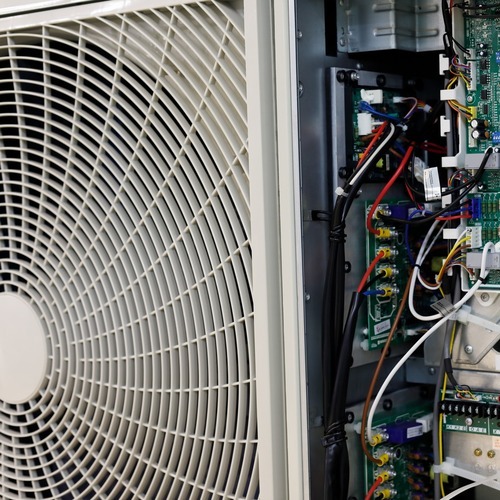
How do I know when I need a circuit control board replacement?
Most HVAC systems have circuit boards that control how it functions. Often, when an HVAC system isn’t cooling or heating as it should, the service technician finds through testing of other possible problems, a circuit control board replacement is needed. Reach out today at 817-579-9377 if you’d like to learn more.
What is a circuit board?
If you’ve ever seen a computer or any electronic taken apart, you probably saw a circuit board, maybe even more than one throughout the item. A circuit board has three layers:
- A conductive layer that is usually made out of copper.
- A layer of fiberglass functioning as an insulating dielectric material.
- An outer layer that functions as the mechanical layer.
The fiberglass sheet is the starting point, each side has conductive copper sheets attached that have a printed etch-resistant wire pattern. With any additional copper on the fiberglass removed, a solid conductive tracing is created. There, electrical components will be connected to the board.
The purpose of a circuit control board is to replace the multiple wiring, condensing it all in one protected place. Holes are drilled into the board so that components of the HVAC system can be connected using an inner layer of copper. This is typically a solid, strong way for an HVAC system to work, but on occasion, a circuit control board replacement is necessary.
Are there different types of circuit boards?
Today, there are six different types of printed circuit boards, referred to as PCBs. They are installed in a variety of ways through different industries. The different circuit control board replacements used are:
- Single-sided: The most commonly used PCB that is found in calculators, electronic toys, and timing circuits.
- Double-sided: A more complex PCB that is used in cell phones and amplifiers.
- Multilayer: Smaller than the other PCBs but more powerful and found in computers and medical equipment.
- Rigid: Cost-effective PCB that is lightweight but cannot be bent or twisted, commonly found in X-ray machines, MRI systems, and GPS equipment.
- Flex: A preferred choice in many cases because it can be bent and twisted, and available in single-sided, double-sided, and multi-layered, commonly used in automotive applications, cameras, and medical devices.
- Rigid-Flex: A hybrid PCB that is designed and built in 3D, is lightweight, and is used in critical applications like aerospace and medical devices.
What usually goes bad on a circuit board?
In most cases, a circuit control board replacement is needed due to human error during assembly and manufacture. Various factors can be the root of the problem like poor layer connectivity, poor soldering, or improperly installing components. It is important at the manufacturing plant of HVAC systems that the company purchases their PCBs from a reliable source to minimize these problems.
How can you tell if a circuit board is bad or has blown?
When you have problems with your HVAC system, the technician will inspect and test several things within the system. During this inspection, he may find where a circuit control board is damaged or non-functioning, thus requiring the installation of a circuit control board replacement. As a homeowner, you would be experiencing any of the following 5 things that could be an indication a circuit control board replacement is needed:
1. Loss of Power: If your HVAC system is losing power, the technician will inspect the system to identify what is causing that problem. It may or may not be related to the PCB, but if testing confirms this is the problem, you’ll need a circuit control board replacement.
2. Burn Marks or Overheating: If the technician finds the PCB to have burn marks, it could be an indication the system is getting overheated, typically because of poor ventilation or the PCB is exposed to high temperatures causing it to short circuit. This is usually connected to parts that are heat-sensitive like capacitors, diodes, and resistors. In addition to replacing those parts, the technician may need to install a circuit control board replacement.
3. Components are Malfunctioning or Non-Responsive: When there are certain features of your HVAC not working properly, like the blower motor or the thermostat, the technician may determine that a circuit control board replacement is needed.
4. A Corroded or Damaged PCB: Any of the problems you’re having with your HVAC system may be caused by the PCB being bent, cracked, or chipped, which requires a circuit control board replacement.
5. Circuit Shorting: If your HVAC system is malfunctioning in an unpredictable, unstable manner, more often than not, a circuit control board replacement is probably needed.
How much does a circuit control board replacement cost?
The brand and model of the HVAC system will be a factor in the cost of a circuit control board replacement. The PCB can cost around $500 on average, some are less and others are more, depending on which PCB is replaced. The labor for a circuit control board replacement can be an additional $300 to $500 charged at an hourly rate of around $200.
The Bottom Line
Yes, a circuit control board replacement can be expensive, especially if your HVAC isn’t still under warranty. So, like many homeowners, you do many things yourself to save money. Is it possible to perform a circuit control board replacement on your own?
If you’re familiar with HVAC systems, PCBs, and all considered in this area, including testing the system to determine the PCB is the problem, you may be able to do this task yourself. However, you could void any warranty on the HVAC system. This is why it’s typically best to leave this job to the professionals. If you’re ready to schedule a replacement give us a call today at 817-579-9377.

